 |
Socio-Political Issues
Color Variations in Communism - Part I
André F. Garcia, Brazil
In many milieus today it is in fashion to affirm that one is a socialist. This earns the warm applause of the media. But to be a socialist is much more than just a fashion; it is adhesion to a type of religion. I believe that both socialists and communists - with their various degrees of compromise or initiation - belong to a unique sect. It is a revolutionary, atheist, materialist and Hegelian sect whose universal action is turned toward the destruction of Christian Civilization and the Catholic Church.
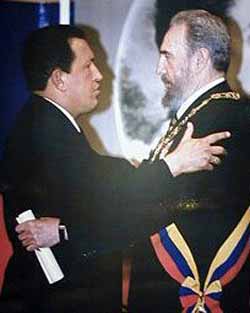
Chavez, the new leader of the Communist Religion in Latin America
|
The sectarian character of so-called Bolivarian Socialism was well-described by Xavier Legoretta, Latin American director of Aid to the Suffering Church. In his analysis of the results of the referendum to reform the Venezuelan constitution that took place in February 2009, he commented:
“I have to say that Chavism [Chavez-ism] has become a kind of religion in Venezuela. Its language, the way it presents itself, its meetings and discussions, everything turns around the person, ideas and strategies of [president] Chavez. This is how he pushes his Bolivarian revolution. His revolution tries to create a model similar to those in [communist] Eastern Europe, which still survives in Cuba - that is, a socialist dictatorship led by a strong personality. In Cuba this leader is Fidel Castro; in Venezuela, it is Hugo Chavez” (1).
The members of the socialist sect are spread out in a broad gamut of political parties, social movements and NGOs (Non-Governmental Organizations), whose colors go from pink to dark red - from so-called democratic Socialism to Maoist, Stalinist or Trotskian Marxism.
For example, the Brazilian Workers Party, PT, is a kind of cheese plate with every socialist tendency represented in it. Possible tactical disagreements do not stand in the way of the fundamental strategic accord that unites them. They share the same revolutionary goal of destroying any remnant of a Catholic and organic State in Brazil and transforming it into a socialist-communist nation. For this reason, no matter which faction’s leader wins the Brazilian presidential election in 2010 - Lula, Dilma, Serra, Aecio or Ciro Gomez - the reins of power will continue to be controlled by the socialist sect.
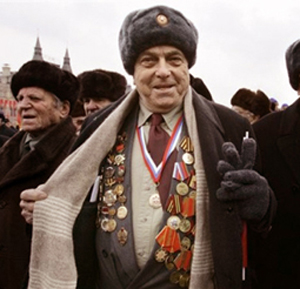
The old nomenklatura returns, glorifying its past |
In the USSR, nomenklatura was the word used to designate the high-placed bureaucrats and elite members of the Communist Party. (2) They formed a privileged philosophical-religious caste and were rewarded or punished insofar as they either adopted or deviated from the tenets of Socialism.
Throughout the world analogous elites control socialist and communist agents who proselytize useful innocents and bring them to their creed. To attract these people, the agents discuss social justice, the distribution of wealth, equality, etc.
To rise in the ranks of the sect, however, what counts is not adherence to the utopian ideals of the “perfect” society raised in those discussions. Instead, the important factor of selection is to know to what degree a neophyte denies “bourgeois morals,” that is, Catholic Morals and Natural Law. If a person does not hesitate to lie, steal, sell his/her body, betray his country and other such immoral things for the advantage of the sect, then he or she is a strong candidate to rise in the sect.
From pink to red
Normally, Socialism and Communism are considered interchangeable. This is understandable since both movements have the same doctrine and goals.
The only difference is in method. While Communism - principally in its Leninist, Stalinist and Maoist versions - uses violence and armed struggle to take power and maintains control through a police State, Socialism uses peaceful, democratic methods to rise to power and achieves its goals slowly and gradually. Communism reaches its goal immediately through a coup d’État, while Socialism achieves the same end by changing the laws and social-economic structures of a nation.
Red Communism tainted itself with the blood of its victims in the countless countries where it was implanted. Experts point to a death toll of 100 million.
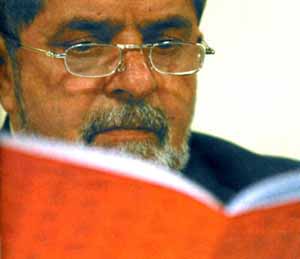
Brazil's President Lula going by the Red Book
|
On the other hand, Socialism appears pink insofar as it comes to power through elections, as it has done in many countries of Latin America in this last decade. However, its hue changes to red to the extent that the free institutions of a nation weaken and allow themselves to be dominated by the elected socialist president. His totalitarian face then becomes more and more visible. Lula in Brazil and Chavez in Venezuela are examples of these variations.
Lula tries to appear pink, presenting himself as “Lula light” or “Lula peace and love.” It is a stratagem to deceive public opinion, to make it easier for people to assimilate socialist habits, laws and structures. When Lula is with his fellow communists, however, he changes his colors, shows his incontrovertible red soul and supports them 100 percent. He has defined himself as being in “a constant metamorphosis.”
Commenting on Chavez in Venezuela and his Bolivarian Socialism, Peruvian writer Mario Vargas Llosa notes: “There is no doubt that this ongoing process is bringing Venezuela closer to a communist dictatorship and farther from a liberal democracy.” He continued: “If this process is not stopped, Venezuela will become the second Cuba of Latin America. We will not permit this – this is why we are here” (El Universal, Caracas, May 28, 2009). Llosa gave this lecture in the Caracas Palace Hotel. (3)
Changing colors in International Communism
Let me take a brief look at a similar process of color change that took place in international Communism.
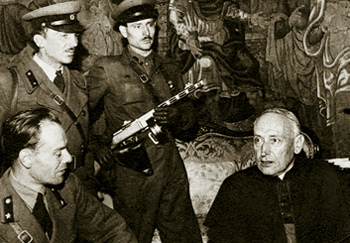
Card. Mindszenty, Primate of Hungary, heroically resisted the communist usurpation of his country
|
From the beginning of the Leninist period until the end of the Stalinist terror, the application of Marxist ideology in Russia was made by means of extreme violence. This was the principal instrument for Marxism to conquer and remain in power. Such violence was also used in other countries - Yugoslavia, China, Vietnam, North Korea, Cuba etc.
As time passed, Marxist ideology revealed its failure to convince the masses. Contributing to this failure was the continuous and heroic resistance inspired by the Catholic Church. The existence of the Church of Silence behind the Iron Curtain and the epic struggle of Cardinal József Mindszenty, Primate of Hungary, are expressive examples of such resistance.
In the late ‘50s and early ‘60s, Communism passed through a metamorphosis, which some call its first perestroika (4). The new despot of the Kremlin, Nikita Kruschev, commissioned a painting of a dove of peace from Spanish communist Pablo Picasso. The message it sent was that Communism had abandoned its hawkish face. Even though the deep-red phase of Communism continued, Russian leaders tried to appear as if they were making a convergence between Socialism and Capitalism.
Some analysts call it neo-Communism, and give it a watery red coloration. The Western media and other propaganda engine spread that those apparent changes in Communism were sincere and should be believed. At the same time, a campaign to discredit anyone who attacked Communism was launched. These were efficient maneuvers of revolutionary psychological warfare (psy-war).
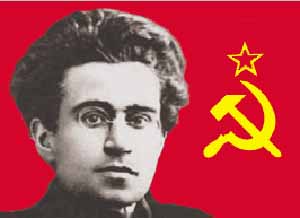
Gramsci: Communism must conquer the West through the Cultural Revolution
|
In the late ‘60s and early ‘70s, the theories of Italian communist Antonio Gramsci returned to the spotlight. Gramsci (+ 1937) defended that Communism should promote an egalitarian culture to gradually conquer capitalist society by changing its ways of thinking and feeling. Thus, according to him, less importance should be given to the political and social class-struggle and more emphasis to the advance of the Cultural Revolution.
In fact, the Gramsci theories re-entered circulation to bolster the new libertarian tendencies unleashed by the revolts of May 1968 in Paris. Even though the essence of Gramsci’s Communism maintained the same Marxist convictions, the emphasis given to this indirect method of conquest were soon considered more moderate and palatable. According to media mythology, the watery red color of Kruschev became almost pink under Gramsci’s new guise.
The ‘80s and early ‘90s were impacted by Gorbatchev’s perestroika (1985), the fall of the Berlin Wall (1989) and the dissolution of the USSR (1991). The first president of the new Russian Federation was Boris Yeltsin (1991-1999). On June 1992 he delivered a speech to the American Congress explicitly affirming that Communism had died and Russia was adopting the social-economic policies of the West.
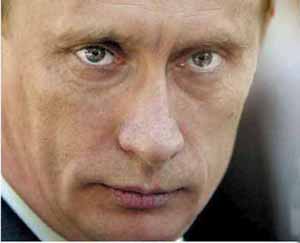
The KGB mentality expressed in Putin's gaze
|
From this time on, the media ceaselessly bombarded the West with the false idea that Communism had disappeared, replaced by an amiable and acceptable Socialism. Thus, a pink deluge inundated the world through the open faucets of the media. It was a colossal psy-war maneuver - a kind of universal hypnosis - that took place for around 15 years. Almost no one could resist the power of that hypnosis and affirm something different. It was “forbidden” to say that Communism was alive. Just a few dared to say this.
Nonetheless, Russia and most of its satellite republics continued to be ruled by communists. China, Vietnam, North Korea and Cuba never changed the orientation of their leaders and their dark red Communist hue.
This hypnosis lasted until the resignation of Yeltsin (December 1999) and the election of Vladimir Putin as president of Russia (March 2000). The spell was broken by the persistent action of adroit anti-communist leaders and various events on the international stage. One of these was the Putin’s rise to power: The frosty gaze of that ex-KGB agent and his clear intention to restore old communist appearances and tactics helped destroy to break the general hypnosis of public opinion in the West.
The Catholic Church becomes red
In parallel, Vatican Council II took place in the Church (1962-1965), and it expressly refused to condemn Communism. The red sect could not have been more content. Thenceforth, an astonishing infiltration of communist ideas, methods and customs entered the Catholic Church. Christian Socialism, Liberation Theology, the preferred option for the poor, the Pastoral Land Commission or Indian Missionary Council are just a few examples of the new red banners hoisted by the Church - that same Church which had been until then the most important bulwark against Socialism and Communism.
1.”Venezuela: Chavismo converteu-se em "religião," Zenit, Rome, February 18, 2009.
2. Nomenklatura, word used in Mikhail Voslensky’s book Nomenklatura: The Soviet Ruling Class, which was based on Milovan Djilas’ book The New Class.
3. Cf. “Para Vargas Llosa, Venezuela será uma 2ª Cuba”
4. During the 20th Congress of the Soviet Union Communist Party (1956), Kruschev distanced himself from Stalinism; in 1958 he became prime minister. Often a parallel is drawn between Kruschev’s position and Gorbatchev’s perestroika (re-structuring) of Communism (1985).

Posted July 17, 2009
André Garcia first published this article in Portuguese on his
Site da Sacralidade
A website to expose Socialism, Communism and defend Christian Civilization

Related Topics of Interest
 Color Variations of Communism - Part 2 Color Variations of Communism - Part 2
 The Growing Russian Military Presence in Latin America The Growing Russian Military Presence in Latin America
 Moscow’s New Onslaught Moscow’s New Onslaught
 A Socialist West? When? A Socialist West? When?
 Forum of São Paulo: Leftist Summit in Montevideo Forum of São Paulo: Leftist Summit in Montevideo
 The Web of Terror The Web of Terror
 Moscow Declares Change in the Global Balance of Power Moscow Declares Change in the Global Balance of Power
 Latin America Is Becoming Communist Latin America Is Becoming Communist
 The Vatican Ostpolitik The Vatican Ostpolitik

Related Works of Interest
|
|
Social-Political | Hot Topics | Home | Books | CDs | Search | Contact Us | Donate

© 2002- Tradition in Action, Inc. All Rights
Reserved
|
 |
|